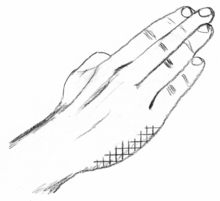
Back Tegatana Spanish Coup du tranchant de la main French Serangan tangan pisau ID 手刀打ち Japanese 손날목치기 Korean Te-gatana Dutch
This article needs additional citations for verification. (November 2007) |
| Knifehand strike | |||||||||||
|---|---|---|---|---|---|---|---|---|---|---|---|
 | |||||||||||
| Chinese name | |||||||||||
| Chinese | 手刀 | ||||||||||
| |||||||||||
| Korean name | |||||||||||
| Hangul | 손날목치기 | ||||||||||
| |||||||||||
| Japanese name | |||||||||||
| Kanji | 手刀打ち | ||||||||||
| Hiragana | しゅとううち | ||||||||||
| |||||||||||
In martial arts, a knifehand strike is a strike using the part of the hand opposite the thumb (from the little finger to the wrist), familiar to many people as a karate chop (in Japanese, shutō-uchi).[1][2] Suitable targets for the knifehand strike include the carotid sinus at the base of the neck (which can cause unconsciousness),[3] mastoid muscles of the neck, the jugular, the throat, the collar bones, ribs, sides of the head, temple, jaw, the third vertebra (key stone of the spinal column), the upper arm, the wrist (knifehand block), the elbow (outside knifehand block), and the knee cap (leg throw).[4]
In many Japanese, Korean, and Chinese styles, the knifehand is used to block as well as to strike.
- ^ "Black Belt - Internet Archive". Internet Archive. p. 42. Retrieved 2015-03-10.
Knifehand strike.
{{cite magazine}}: Cite magazine requires|magazine=(help) - ^ "Black Belt - Internet Archive". Internet Archive. p. 56. Retrieved 2015-03-10.
Knifehand strike.
{{cite magazine}}: Cite magazine requires|magazine=(help) - ^ Kharsa, Antoine; Wadhwa, Roopma (2022), "Carotid Sinus Hypersensitivity", StatPearls, Treasure Island (FL): StatPearls Publishing, PMID 32644485, retrieved 2022-10-07
- ^ "Black Belt - Google Books". July 1995. Retrieved 2015-03-10.